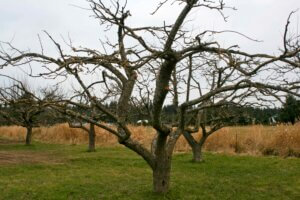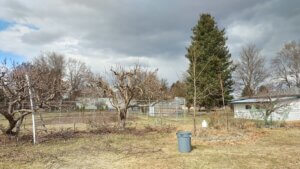Bearing Fruit
Temperatures are rising, daylight is lengthening and trees will soon begin to awaken from their winter slumber. As spring approaches, the trees are preparing to bloom again which means this is fruit tree pruning season!

(Image Credit: Swansonsnursery.com)
Its orchard ladders, loppers, hand pruners, and hand saw time for us here at Grace Tree Service. One of the questions that we get from our clients frequently is when is the best time to prune fruit trees? While some customers have their fruit trees pruned in the fall dormant season, February and March are our two big fruit tree pruning months. Neither is wrong, just as long as we aim for a start between late October and finish by early April.
Since fruit trees will produce fruit without pruning as long as blossoms form, the blooms are not damaged by frost and pollinators help spread pollen so why prune fruit trees?

Fruit tree pruning is performed annually to keep fruit trees at a manageable height for picking fruit, and create a form/structure to get the optimum size, quality, and quantity of fruit. It is also done so the tree can support the weight of its fruit. A fruit tree left unpruned will grow much like a normal ornamental or shade tree. The difference is, that the fruit will grow higher each year, the fruit will begin to shrink in size and quality, and the likelihood of the branches breaking under a heavy fruit crop increases greatly.
Fruit tree pruning is a true craft. A combination of individual artistic license and science. It took me several years to fully understand all the little nuances of fruit tree pruning as I returned each year to see how the tree responded to specific cuts, and pruning techniques and learn about the quality and quantity of fruit they produced.
Each year at this time, I usually write a series on the specific objectives and principles of fruit tree pruning. For a few weeks, I thought we would stick with this topic and clear the air on some very common misunderstandings about fruit trees. This blog covers parts one and two of our series on fruit tree pruning published in our local newspaper. While a comprehensive guide to fruit tree pruning requires more years of experience than it does word count, we can provide some basic starter guidelines on how to prune a fruit tree to get you started in a successful manner.

As I reflect on all the fruit trees we have worked on over the years, I find myself writing in lots of disclaimers and exceptions. Each species and cultivar needs to be pruned differently, and further pruning considerations must be made for individual trees depending on age, vigor, if it has been properly or improperly pruned in the past, and how often it was maintained. Apple tree pruning is not the same as pear tree pruning which is different than plum tree pruning which… you get the idea.
Honestly, it is more impactful if you want help with your personal fruit trees to invite us out for a hands-on consultation. I have never heard anyone tell me that the consultation cost wasn’t worth every penny.
Rather than writing out general fruit tree concepts this year, I thought I would address some of the most common questions and misguided information we hear from customers every year.
One common statement we hear is, “I’ve heard you just cut off everything growing up”. This radical upward growth called “Water Sprouts” is a response to the prior year’s fruit tree pruning, and it is important NOT to cut them all off. There needs to be a balance. Water sprouts are primarily leaf-bearing branches and if you remove all of them, the tree must use a lot of stored energy to regrow those branches. Pruning out a third to half of the tallest ones is a better choice. Leaving the shortest ones spaced 6-12 inches apart along the limbs will ensure the tree has branches to produce leaves right away in the spring. With a thinned canopy of water sprouts left, the tree can begin the process of photosynthesis and put energy into fruit production right away.
Our next blog post will feature parts three and four of this series where we will address some basic rules used to reign in old unkempt fruit trees. We often find our customers in these situations when they purchase a new home or property with existing unmaintained fruit trees and want them pruned into shape so they can have fall fruit. So stay tuned for the next blog post or find the next parts in our local paper if you live in North Idaho and are looking for a fruit pruning service near you.

